All 2 entries tagged Anubis
No other Warwick Blogs use the tag Anubis on entries | View entries tagged Anubis at Technorati | There are no images tagged Anubis on this blog
April 27, 2023
A silver token of Julian in the Ashmolean Museum, Oxford
Among the Roman tokens now in the Heberden Coin Room in the Ashmolean Museum is a silver token made of silver issued by Julian (AD 361-363), the last descendant of the Constantinian dynasty (Fig. 1). On the obverse of the token we find a pearl-diademed, draped, and cuirassed bust of the ruler left, holding Victory on a globe in his right hand and a shield decorated with a she-wolf and twins motif over his left shoulder; although the specimen has a segment broken away from both top and top left hand sides, the obverse legend can confidently be restored as D N FL [CL IVLI-ANVS P F AVG] based on comparison with other known similar token pieces, as will be shown below. On the other side is an image of Anubis standing left, wearing a tunic, a mantle over his shoulders and boots, holding a branch in his right hand and a caduceus in his left, which is accompanied by the legend VOTA [PVB]LICA.
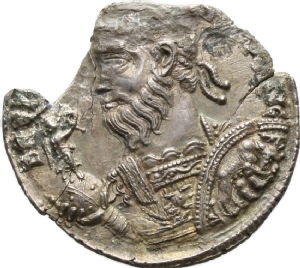 |
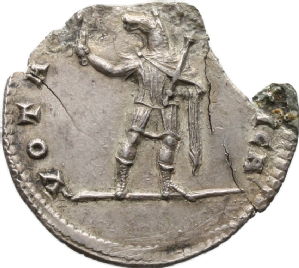 |
Fig. 1: AR, ‘Vota Publica’ token, Rome, AD 361-363 (24mm, 3.45g). Courtesy of the Ashmolean Museum, inv. HCR71367. © Ashmolean Museum.
The imagery and the reverse legend allow us to connect this specimen with a late Roman series, the ‘Vota Publica’ tokens, which were struck by the mint of Rome from the first Tetrarchy (AD 294–305) through at least the first two generations of the Valentinian dynasty (AD 364–378). These tokens display portraits of Roman emperors or Egyptian deities (Serapis, Isis, Hermanubis, or the jugate busts of Serapis and Isis) on the obverse, in conjunction with a variety of depictions referring to different aspects of Egyptian and Isiac cults on the reverse. Although auction catalogues and occasional academic contributions have mostly connected these artefacts to the Navigium Isidis, the renowned festival of Isis which was annually held on the 5th of March, the regular presence of the ‘Vota Publica’ legend as well as the dates of accession and death of imperial rulers that are portrayed on the obverses support instead the idea that these pieces were produced on the occasion of the annual vows (‘vota publica’) collectively pronounced for the health of the Roman emperor on the 3rd of January against the backdrop of New Year celebrations.
The token housed in Oxford, formerly in Prince of Waldeck’s collection (XVIII century), is of great interest not only for the high quality of its designs and workmanship, but also for the metal of which it is made, namely silver. Indeed, the use of silver does deviates from the common patterns seen for the ‘Vota Publica’ tokens, which were normally produced in brass and bronze. This raises questions about manufacturing methods and relevant changes that took place within token production during Julian’s reign.
 |
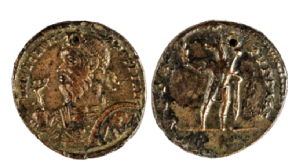 |
Fig. 2: a. AE, ‘Vota Publica’ token, Rome, AD 361-363 (24mm, 4.05g). Numismatica Ars Classica 92, 23-24.05.2016, lot 766. b. AE, ‘Vota Publica’ token, Rome, AD 361-363 (25mm, 6.30g). Courtesy of the Museo Arqueológico Nacional (MAN) of Madrid, inv. 2014/66/67. © Museo Arqueológico Nacional (MAN) of Madrid.
A closer look at the imagery of the token and its relationship to other surviving tokens of Julian from the same series allows us to make some remarks on its chronology and production context. Based on a recent classification of the available material (Bricault & Mondello, forthcoming), Julian’s ‘Vota Publica’ tokens can be sorted into five major groups consisting of die-linked specimens, which were struck in either bronze or brass in three modules, AE1-AE2 (c. 21-27mm) (Julian, Group 1) and AE4 (c. 12–15mm) (Julian, Groups 2–5). Interestingly, Julian’s effigy is shown here according to three variants. Of them, the obverse portrait displayed on the Oxford token is shared by some of the clusters from Group 1 showing different Egyptian images on the reverse (Fig. 2a). Moreover, die analysis shows that the Oxford silver token was issued with the same obverse and reverse dies that were used to strike a specimen made of bronze, now in Madrid (Fig. 2b). The imperial portrait found on these specimens is unparalleled within the official coinage, and was probably an original creation by the Roman mint expressly for the ‘Vota Publica’ series. Two other portraits attested on these tokens instead reproduce or imitate the imperial portraiture found on regular Roman coins: a left–facing and helmeted bust of Julian, holding a shield over his left shoulder (Julian, Group 2) (Fig. 3a), as found on the VOT X MVLT XX silver and bronze coin issues issued at most of the major mints in anticipation of Julian’s decennalia (Fig. 3b); and the common type of the imperial bust right, with cuirass and paludamentum, short or long–bearded (Julian, Groups 1–5) (Fig. 4a), as seen on the small VIRT EXERC ROMANOR bronzes by the Roman mint (RIC VIII, Rome, 327) (Fig. 4b) and, more generally, on solidi and large bronzes issued by other mints in AD 362–363.
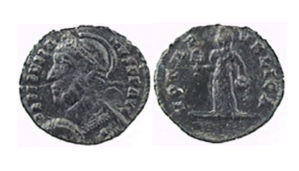 |
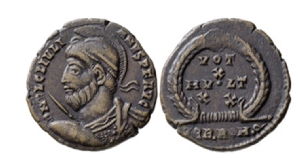 |
Fig. 3 a. AE, ‘Vota Publica’ token, Rome, AD 361-363 (15mm, 1.74g). Courtesy of the Museo Civico di Bologna, inv. 47046. © Museo Civico di Bologna. b. AE, VOT X MVLT XX coin, Rome, AD 363 (18.8mm, 3.17g) (RIC VIII, Rome, 329). Courtesy of the Münzkabinett der Universität Göttingen, inv. AS-04485 © Münzkabinett der Universität Göttingen.
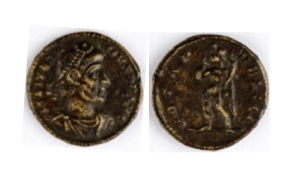 |
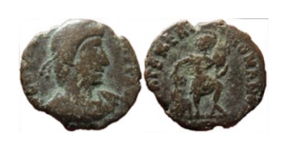 |
Fig. 4 a. AE, ‘Vota Publica’ token, Rome, AD 361-363 (14mm, 1.57g). Courtesy of the Museo Arqueológico Nacional (MAN) of Madrid, inv. 2014/66/203. © Museo Arqueológico Nacional (MAN) of Madrid. b. AE, VIRT EXERC ROMANOR coin, Rome, AD 362-363 (14mm, 1.32g) (RIC VIII, Rome, 327). From a private collection.
The imperial titulature, which reads D N FL CL IVLIANVS P F AVG (Group 1) or FL CL IVLIANVS P F [or P P] AVG (Groups 2–5), along with the comparison with coin imagery allow for a more precise chronology of these token issues. According to Kent, the title D(ominus) N(oster) seems not to have entered general use within Julian’s coinage until after the start of 363 (Kent 1959, p. 114; RIC VIII, pp. 46, 54). Following Kent’s suggestion, the silver token held in Oxford, as well as the large–sized ‘Vota Publica’ tokens from Group 1 bearing a long imperial legend including D N, might date back to the celebrations of the vota publica of the 3rd January 363, as also pointed out by the style of the imperial effigy with a long beard, which clearly refers to Julian’s later coinage. The same dating can be applied to tokens from Group 2, the obverses of which are similar to dies from the VOT X MVLT XX issues apparently struck by the Roman mint in AD 363 (RIC VIII, Rome, 328–330), although the former retained a short imperial titulature not found on the latter. Less clear is instead the chronology of the specimens from Groups 3-5. The portrait and the short imperial legend on the obverse of these pieces, as well as their size - matching the pre–reform VIRT EXERC ROMANOR issues (= AE4) - may date them to the previous year, that is the 3rd January 362, although one cannot completely rule out the idea that they were also part of the AD 363 token issue.
The existence of a ‘Vota Publica’ token made of silver clearly suggests that a small cluster was produced in precious metal within this late Roman series during the reign of Julian, in addition to the more common bronze and brass issues. While the actual purpose of these tokens remains debated (= devices issued as a means of pagan propaganda? Auspicious gifts distributed during New Year celebrations?), it is possible that the choice of manufacturing silver tokens resulted from a more general ‘revival’ of the ‘Vota Publica’ series which took place under Julian. Indeed, the evidence shows that the production of these specimens during the reign of the last Constantinian emperor saw a relative iconographic renewal of the reverse repertoire via the use of a new set of Egyptian types, as well as a reintroduction of the large-module denominations (AE1-AE2), which were earlier only struck for the first ‘Vota Publica’ issues at the time of the first two Tetrarchies (AD 294-305) and then replaced by mostly small-sized denominations (AE4) from Constantine I (AD 313-330/331). Such a ‘revival’ of this token series showing Egyptian religious iconography is not surprising in light of Julian’s religious reform and his (short-lived) attempt to restore Hellenistic polytheism as the state religion. However, this production pattern, based on a trimetallic system (silver, orichalcum, and bronze) for the ‘Vota Publica’ tokens, apparently did not succeed and was not followed by Julian’s successors (Jovian and the Valentinian emperors up to Gratian), who only resumed manufacturing these tokens in brass and bronze – or at least there is no evidence to demonstrate otherwise. Whatever the purpose of these tokens, it may be argued that the use of silver to strike some of Julian’s token issues may have been matched by a higher exchange value compared to that of brass and bronze specimens, which also had the effect of providing a more valuable appearance to the object and the same level of aesthetic quality as found on silver coins and medallions.
This blog was written by Cristian Mondello as part of The ‘Vota Publica’ Tokens from Late Antique Rome: Isiac and Egyptian Cults within a Christianizing Roman Empire project, which has received funding from the NRRP, Mission 4, ‘Education and Research’ – Component 2, ‘From Research to Business’ – Investment line 1.2, ‘Funding projects presented by young researchers’ (European Union – NextGenerationEU, proposal no. CFFE1C55). The project is hosted at the University of Messina, Italy.
Select bibliography
Alföldi A., Isis-szertartások Rómában a negyedik század keresztény császárai alatt = A Festival of Isis in Rome under the Christian Emperors of the IVth Century, Budapest 1937.
Bricault, L., & Mondello, C., Isis Moneta. The ‘Vota Publica’ Tokens from late antique Rome. Volume 1: Catalogue, London (forthcoming).
Kent, J.P.C., ‘An Introduction to the Coinage of Julian the Apostate’ (A.D. 360–3), The Numismatic Chronicle and Journal of the Royal Numismatic Society, 6.19 (1959), pp. 109–117.
RIC VIII = Kent, J.P.C., The Roman Imperial Coinage. The family of Constantine I. A.D. 337–364, Vol. VIII, London 1981.
October 26, 2016
Anubis Tokens and the Festival of Isis in Late Antique Rome
As part of the Token Communities project I have been examining the Roman lead tokens housed in the British Museum. Amongst the tokens are several that show the Egyptian goddesses Isis and Anubis. One example of these type of tokens is shown below: one side of the token shows Isis with a sistrum (a type of musical instrument associated with the goddess) and what may be a situla (a type of bucket). The legend on the left reads ACICI. The other side of the token shows the dog-headed god Anubis with a branch and a rather stylised sistrum.
 |
| Lead token with Isis on one side and Anubus on the other. |
The designs reminded me of the Isis coins of late antiquity, which are gathered together in Alföldi's 1937 book A Festival of Isis in Rome under the Christian Emperors of the IVth Century. Alföldi observed that even as late as the fourth century AD coins were being struck in Rome with the imperial portrait on one side and the Egyptian gods Isis and Sarapis on the other. Another series, which Alföldi called the 'anonymous' series, was also struck in the city. These had Isis or Sarapis on the obverse and various Egyptian motifs on the reverse: they did not name or show an emperor (an example is shown below). Alfödi suggested that this 'anonymous' series was created in the official mint after AD 378-9, the date at which coins showing the imperial portrait in association with Egyptian deities ceased. Alföldi believed that although the increasingly Christian emperors could no longer be associated with Isis or Sarapis, the (pagan) senatorial elite in Rome continued to produce coin-like objects for the festival of Isis, which could be given to their clients. Without the imperial portrait, these pieces weren't officially currency, Alföldi suggested, but instead were gifts given by select senators to their clients (and these pieces, in turn, may have later been used as playing pieces or small change).
 |
| 'Anonymous' issue with the portrait of Isis and figure of Anubis. |
On the anonymous series Anubis carries a sistrum and (stylised) caduceus, and is accompanied by the legend VOTA PVBLICA. This legend is also found on the coins struck with the imperial portrait, and probably references the fact that the festival of Isis in Rome was often connected with vows for the health and safety of the emperor. There are stylistic similarities, particularly with the sistrum held by Anubis, between the coins and the tokens. This, and the unusual appearance of Anubis at all, leaves me to wonder whether the lead tokens are not also from the same time period, and connected to the same, or a similar festival for Isis. If the elite were already creating 'anonymous' coin-like objects for use in the festival, perhaps the lead tokens with Anubis were a complementary or later development. While the Anubis British Museum tokens don't have any find data associated with them, they were catalogued by Rostovtzeff in his catalogue of tokens from Rome and the suburbs (Tesserarum Urbis Romae et Suburbi Plumbearum Sylloge no. 3190), and similar tokens were mentioned by Ficorini in his 1740 work. Specimens are also held in the Museo Nazionale in the Baths of Diocletian in Rome and in the Vatican, suggesting that maybe these are tokens that come from Rome, despite their Egyptian motifs. Other lead tokens also show strikingly similar imagery to the late antique coins associated with the festival.
Until further data is found this is just an idea, but perhaps we should add these tokens into the discussions of the yearly festival of Isis in late antique Rome.
This blog was written by Clare Rowan as part of the Token Communities project.
Anonymous series coin image reproduced courtesy of Numismatica Ars Classica, Auction 92 Part 1, lot 772.
 Clare Rowan
Clare Rowan

 Please wait - comments are loading
Please wait - comments are loading

 Loading…
Loading…

